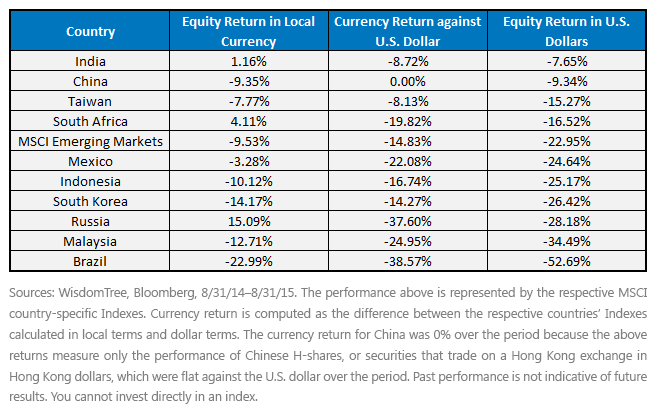Revisiting the Opportunity in India


 For definitions of indexes in the chart, visit our glossary.
• India a Top-Performing Country: Over the past year, India was the top-performing country listed above in U.S. dollar terms and a top-three performing country in local terms. India outperformed broad emerging markets, represented by the MSCI Emerging Markets Index, by 10.69% in local terms and 15.29% in U.S. dollar terms. India’s currency was relatively resilient over the year compared to the U.S. dollar as a result of improvements in its current account and falling inflation.
Opportunities Remain in India
At WisdomTree, we believe in the long-term potential of India’s equity markets, especially given the tag team of prime minister Narendra Modi and Raghuram Rajan, governor of the Reserve Bank of India. These two have brought and can continue to bring investor-friendly pro-growth reforms and credible monetary policy, respectively. These initiatives, coupled with lower oil prices and improving profitability, provide an opportunity for India within emerging markets.
The WisdomTree India Earnings Index (WTIND) is the broadest and most representative Indian index and the only index that focuses exclusively on profitable companies. Every year, at the end of August, WisdomTree screens the investable Indian equity market for the rebalance of its Index, which provides a plethora of information on the health and profitability of the market.
India’s Earnings Stream Grew 8.66%
In rupee terms, despite the relatively flat performance of Indian stock prices, the WTIND Earnings Stream grew by 8.66%1. The decline of the rupee against the U.S. dollar translated to a fall in earnings of 1.09% in dollar terms. It is interesting that over the period we saw earnings outpace prices, so each dollar of earnings became less expensive, improving the market fundamentals.
While broad-based profit growth is typically supportive for equity markets, we think it is important to have a rules-based process that can identify and capitalize on the companies increasing their profits. WTIND seeks to provide exposure to the profitable core market of India’s equities while maintaining sensitivity to valuation. To help achieve this, WisdomTree weights companies in the Index by the profits they generate, rather than their market cap, and rebalances back to profitability on an annual basis.
WisdomTree’s India Earnings Index rebalance process typically is driven by the following:
• Earnings Growth: Companies that grow their profits typically see their weight increased. At the most recent rebalance, the companies that saw their weight raised had a median earnings growth of 30.3%, which was greater than the 16.2% median earnings growth of all companies and the 7.3% growth for companies that saw their weight lowered.
• Relative Performance:
For definitions of indexes in the chart, visit our glossary.
• India a Top-Performing Country: Over the past year, India was the top-performing country listed above in U.S. dollar terms and a top-three performing country in local terms. India outperformed broad emerging markets, represented by the MSCI Emerging Markets Index, by 10.69% in local terms and 15.29% in U.S. dollar terms. India’s currency was relatively resilient over the year compared to the U.S. dollar as a result of improvements in its current account and falling inflation.
Opportunities Remain in India
At WisdomTree, we believe in the long-term potential of India’s equity markets, especially given the tag team of prime minister Narendra Modi and Raghuram Rajan, governor of the Reserve Bank of India. These two have brought and can continue to bring investor-friendly pro-growth reforms and credible monetary policy, respectively. These initiatives, coupled with lower oil prices and improving profitability, provide an opportunity for India within emerging markets.
The WisdomTree India Earnings Index (WTIND) is the broadest and most representative Indian index and the only index that focuses exclusively on profitable companies. Every year, at the end of August, WisdomTree screens the investable Indian equity market for the rebalance of its Index, which provides a plethora of information on the health and profitability of the market.
India’s Earnings Stream Grew 8.66%
In rupee terms, despite the relatively flat performance of Indian stock prices, the WTIND Earnings Stream grew by 8.66%1. The decline of the rupee against the U.S. dollar translated to a fall in earnings of 1.09% in dollar terms. It is interesting that over the period we saw earnings outpace prices, so each dollar of earnings became less expensive, improving the market fundamentals.
While broad-based profit growth is typically supportive for equity markets, we think it is important to have a rules-based process that can identify and capitalize on the companies increasing their profits. WTIND seeks to provide exposure to the profitable core market of India’s equities while maintaining sensitivity to valuation. To help achieve this, WisdomTree weights companies in the Index by the profits they generate, rather than their market cap, and rebalances back to profitability on an annual basis.
WisdomTree’s India Earnings Index rebalance process typically is driven by the following:
• Earnings Growth: Companies that grow their profits typically see their weight increased. At the most recent rebalance, the companies that saw their weight raised had a median earnings growth of 30.3%, which was greater than the 16.2% median earnings growth of all companies and the 7.3% growth for companies that saw their weight lowered.
• Relative Performance:
Important Risks Related to this Article
Investments focused in India are impacted by events and developments associated with the region, which can adversely affect performance.
Investments in emerging, offshore or frontier markets are generally less liquid and less efficient than investments in developed markets and are subject to additional risks, such as risks of adverse governmental regulation and intervention or political developments.


